Content
Hydrangea Pink Annabelle is a young variety of tree hydrangea, distinguished by its hardiness and resistance to winter frost. It looks like a large bush up to 1.5 m in height and almost 1 m in width. At first, it blooms in different pink shades, but by the middle of summer it is "determined" with a color - light or dark pink.
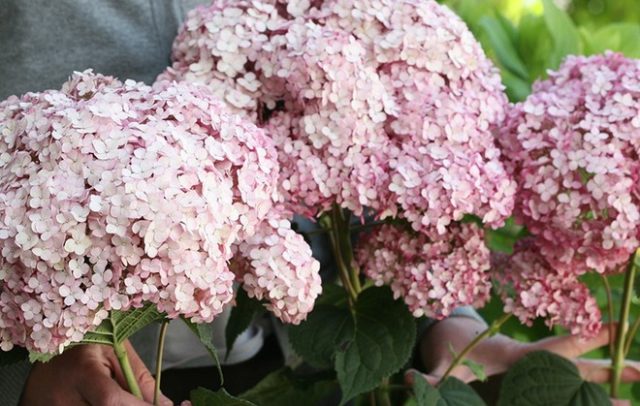
Pink Annabel is one of the hardiest hydrangea varieties
Description of hydrangea tree-like Pink Anabel
Treelike hydrangea (hydrangea arborescens pink annabelle) is a new variety of the Annabelle hydrangea species. It is considered the most hardy, unlike its predecessors. Height and width about 90-120 cm. Strong shoots do not stick to the ground, despite the heavy, massive buds.
Inflorescences consist of a large number of flowers, externally spherical, pink shades. At the beginning of flowering, the upper petals are pale pink, and closer to the base they are dark pink. Over time, the gradient effect disappears, leaving a light or dark color of inflorescences.
Flowering is long, from about the beginning of summer until frost.
Hydrangea Pink Anabel in landscape design
Hydrangea tree Pink Anabel, as seen in the photo below, is widely used in landscape design.
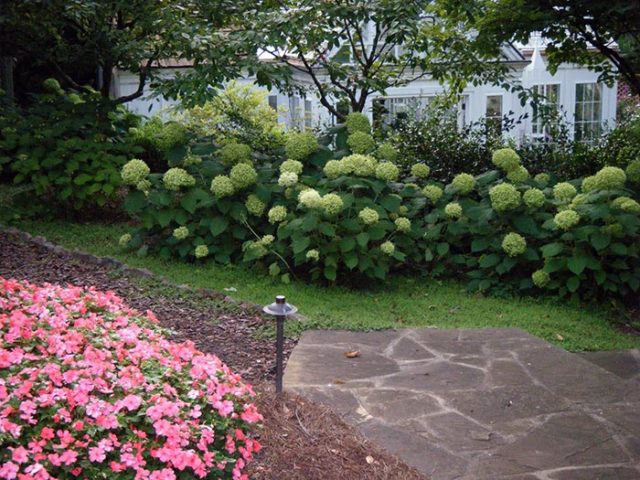
Hydrangea is planted on a plot in recreation areas, along with a lawn or perennial plantings, in the garden and front gardens
Use separately tree hydrangea or arrange group plantings with other species of this plant.
Winter hardiness of hydrangea varieties Pink Anabel
Most types of hydrangeas require greenhouse conditions for the winter, which are warming the soil, covering the bush with several layers of polyethylene, etc. However, with tree varieties, everything is easier, they tolerate winter well. Only slight hilling is required, as well as pruning of faded inflorescences. The latter is done from the considerations that shoots can break under the weight of snow. On the other hand, if the grower is ready to regularly shake off the snow accumulating on the plant, then there is no need to cut off the inflorescences. Moreover, due to their integrity, the buds located inside the bush will be better preserved.
Not stiff shoots require special attention, they should be cut off, since they will not survive the winter.
Planting and caring for hydrangea tree-like Pink Anabel
In general, the Pink Anabelle hydrangea tree does not require elaborate planting and maintenance techniques. She prefers moisture, does not like the scorching rays of the sun, and tolerates wintering well. Regular watering, warming the roots for the winter, complementary feeding of the soil will provide a colorful bloom of hydrangea for many years.
Selection and preparation of the landing site
The landing site is of great importance. With the right choice, the plant will delight the grower for many years. The main thing is that the selected landscape is protected from strong gusts of wind and drafts.
Hydrangea can be planted next to a high fence or decorative trees, they will serve as protection from drafts. In addition, the species does not like the direct scorching sun, although it needs a sufficient amount of it. All the same trees will help protect the plant from direct sunlight.
However, hydrangea is moisture-loving, which means that it will not like trees with a large root system, which will "steal" water from it. Dry soil can prevent it from blooming. However, if the grower can provide the hydrangea with enough moisture, then other people's roots are not a problem. Still, "ornamental" trees are a better choice.
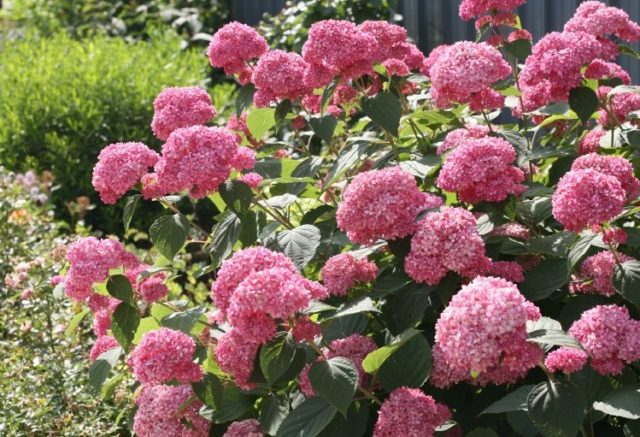
Pink Annabelle is planted by the fence or in the shade of trees
Landing rules
It is recommended to plant the tree hydrangea Pink Anabel in spring or autumn, in May or September. The weather during these periods is warm enough without the scorching sun. In the spring, pay attention to the appearance of hydrangea seedlings. The buds should be formed, but have not yet opened.
For planting hydrangeas, they dig holes twice as large as the root system, loosen the soil around. Prepared holes are first watered and waited for excess moisture to be absorbed into the ground. Then the seedlings of tree hydrangea are planted so that the root collar is subsequently underground and does not look out to the surface. The hole is covered with soil, which can be pre-mixed with peat to increase the acidity of the soil.
What matters is the type of roots, whether they were in a container, a bag or naked. The first ones are straightened well, because they could intertwine. Bare roots are planted before bud break or after leaf fall. When the plant is covered with soil, it is crushed so that the roots come into contact with the ground.
Watering and feeding
Hydrangea loves moisture, so you will have to water it regularly. It is noteworthy that it is worth watering the plant from above, the water will wash away excess dust, refreshing the appearance of the hydrangea. In addition, if there is a danger of aphids, regular "washing" of the plant will help to bring down the pest, press it to the damp ground.
Top dressing is carried out in the spring or summer using mineral fertilizers. For flowering periods, organic species should be preferred. The soil is fertilized with humus, mixed with peat, sprinkled with leafy soil.
Pruning Pink Anabel hydrangea
Most of the hydrangea is needed to give it the shape it needs. In the process, faded buds, dried flowers, old shoots are removed.
Sometimes it is recommended to prune before wintering, remove non-stiff shoots, because they will not tolerate the cold, and also remove the inflorescences so that the stems do not break under the weight of the snow falling on them. However, the latter can be left, just regularly brush away snow from them. This way, the hydrangea buds located inside the bush will be much better preserved.
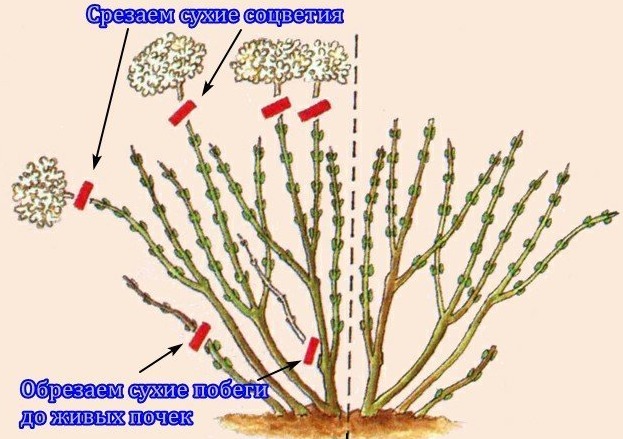
In general, pruning is carried out like most plants.
Cut off dry buds and shoots to live buds. Gardeners disagree on whether to remove faded inflorescences. Some leave them to protect the buds from the cold, others cut off the inflorescences in order to avoid damage to the plant due to the heaviness under the snow cap.
Preparing for winter
Preparing for winter will not require a waste of energy, because this variety of tree hydrangea is frost-resistant. Most other species are wrapped for the winter, create greenhouse conditions. In the case of tree hydrangea, only the roots can be insulated, carrying out the so-called mulching. A small area of earth around the trunk is sprinkled with sawdust, dry foliage, bark and chips, as well as gravel, rubble and other decorative materials. This is necessary to prevent evaporation of moisture from the soil, the appearance of pests, hypothermia. At the same time, organic mulching enriches the soil, improving its structure.
In general, the plant can be tied up to prevent it from bending under the snow, which needs to be brushed off the hydrangea regularly.
Reproduction
The best and fastest way to propagate tree hydrangea is considered to be cuttings, that is, using individual stems. It is noteworthy that they will have the genetic information of the main plant, so no differences and "surprises" in its germination can be expected.
Cuttings are done in summer with green stems, which is considered the most optimal choice. The procedure is carried out in mid-July, early in the morning, so that the plant is filled with moisture, preferably with new fresh growths.
Cut closer to the base, at the very bud, leaving one or two leaves, which are cut in half. If the shoot is with a bud, it is cut off.
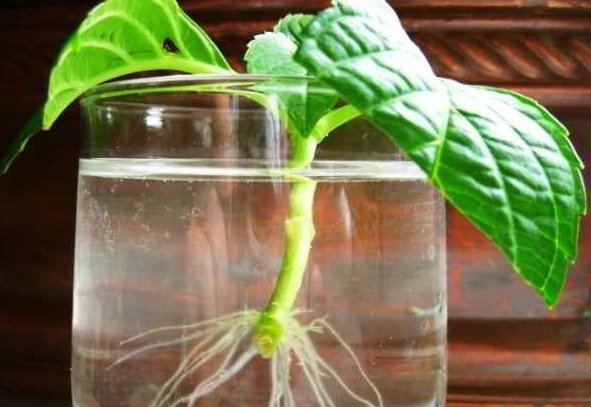
The stalk is placed in a 200-300 ml jar and left in the shade until roots appear.
Florists advise adding 1 tsp to the water. honey, it will contribute to the thickening at the end of the cutting, from which the roots will crawl.
When the cuttings of the tree hydrangea give roots, they are transplanted into small containers with peat mixed with sand in a ratio of 2 to 1. The earth is pre-moistened, and then watered once a week if the air humidity is not too high. In August, the plants show their first roots, but it is too early to plant them. For the winter, they create greenhouse conditions and only in the spring are cuttings taken out to the beds.
Diseases and pests
Treelike hydrangea is one of the most disease-resistant plants. She does not suffer from outlandish and difficult to remove ailments, but is prone to ordinary aphids.
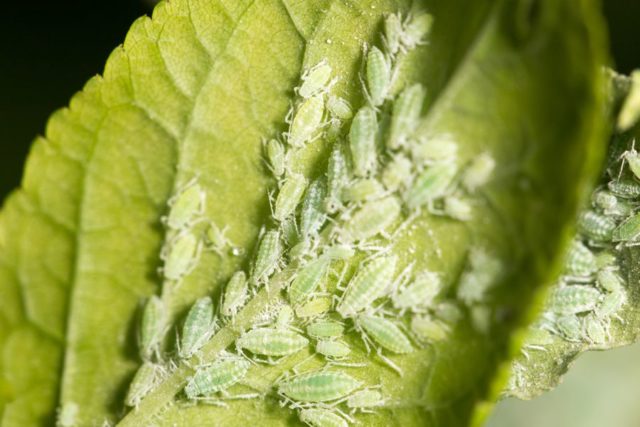
It is easy to fight the pest with plain water, which is sprayed on the whole plant, knocking down insects
Laundry soap is also used, which must be rubbed in 1 liter of water in an amount of 100 g. It can be replaced with tar soap, which will be no less effective. The soap is dissolved in water, poured into a spray bottle and sprayed over flowers, foliage and stems. You can cultivate the soil around the plant.
A painful appearance signals some deficiencies in care:
- "Rusting" foliage says that there is too much water, or the plant is "stuffy";
- leaves drying out from the tips signal that there is little moisture, so it will not be superfluous to water the plant not only near the soil, but also to spray it entirely;
- "Burns" on foliage indicate that the plant needs more shade, they overheat in the sun.
Conclusion
Hydrangea Pink Annabelle stands out for her beauty. She not only decorates any area, but also does not require complex care manipulations. Treelike hydrangea will "forgive" beginners for the first awkward care attempts, therefore it is considered a good choice.
Reviews of hydrangea Pink Anabel
Hydrangea Pink Annabelle is gradually winning the hearts of many gardeners, both beginners and experienced.








